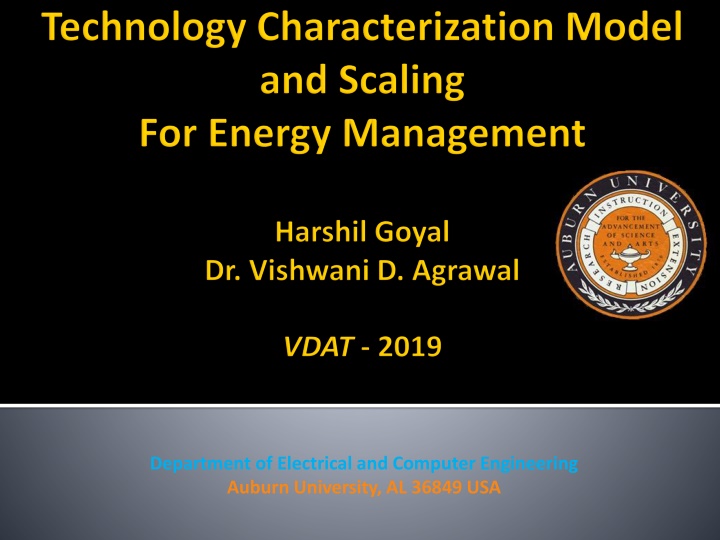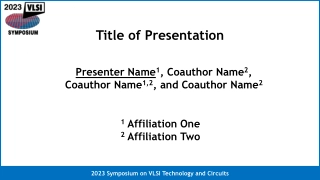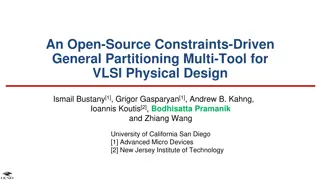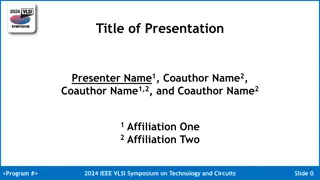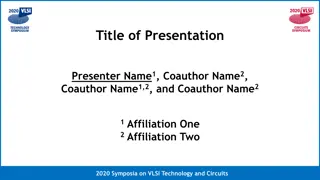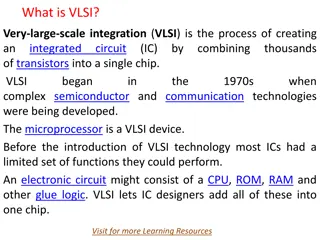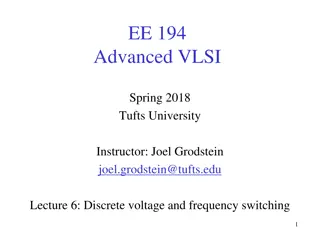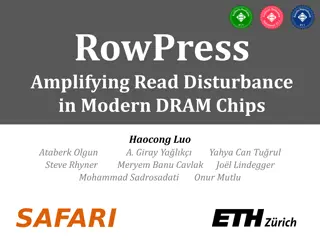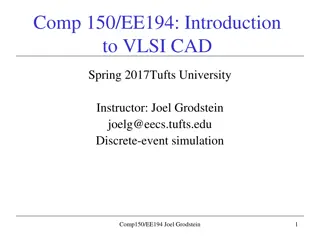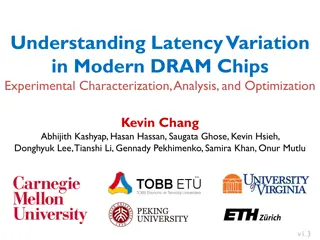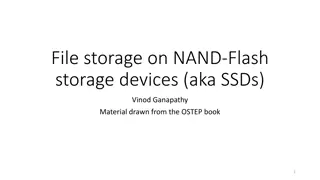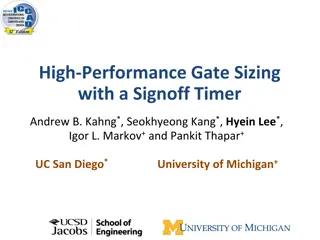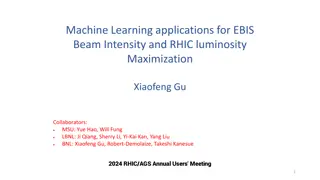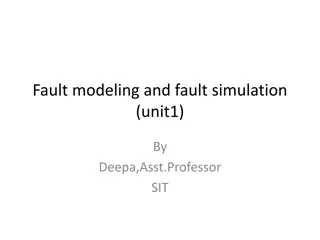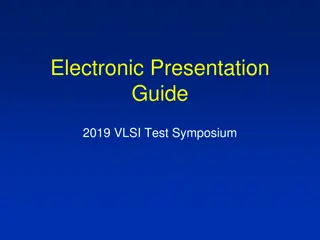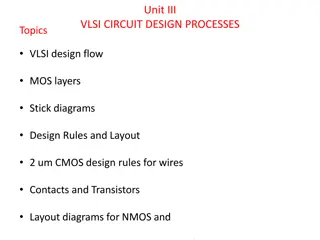Application-Specific Optimization of VLSI Chips
VLSI chips, like microprocessors, often come with generic operating conditions. To optimize for specific applications, power-delay characterization at various voltages is crucial. This involves obtaining data on voltage, frequency, and cycle efficiency for time and energy optimization, determining optimal operating conditions, and considering challenges in experimental setup and simulation.
Uploaded on Mar 12, 2025 | 0 Views
Download Presentation

Please find below an Image/Link to download the presentation.
The content on the website is provided AS IS for your information and personal use only. It may not be sold, licensed, or shared on other websites without obtaining consent from the author.If you encounter any issues during the download, it is possible that the publisher has removed the file from their server.
You are allowed to download the files provided on this website for personal or commercial use, subject to the condition that they are used lawfully. All files are the property of their respective owners.
The content on the website is provided AS IS for your information and personal use only. It may not be sold, licensed, or shared on other websites without obtaining consent from the author.
E N D
Presentation Transcript
Department of Electrical and Computer Engineering Auburn University, AL 36849 USA
Introduction Problem Statement Background Methodology Simulation setup Results Applications Conclusion 3/12/2025 2
Most VLSI chips, including microprocessors, come with prescribed operating conditions, found in specifications supplied by the manufacturer. While such specifications serve a majority of users, they are not optimized for specific applications. Application-specific optimization of operation requires power-delay characterization of the chip at various supply voltages. 3/12/2025 3
Obtain data on voltage, frequency and cycle efficiency of the processor for time and energy optimization. Determine operating conditions (voltage and frequency) for optimal time and energy operation. 3/12/2025 4
Experimental set up is expensive. Simulation requires a complete model of the chip, often not available from the manufacturer. Even if a simulation model is available, accurate timing and power analysis can be expensive. 3/12/2025 5
Time Performance of Processor Speed of a processor is measured in cycles per second or clock frequency (f). Execution time of a program using C clock cycles = C/f Time performance = f/C Energy Performance of a Processor Efficiency of a processor may be measured in cycles per joule or cycle efficiency ( ). Energy dissipated by a program using C clock cycles = C/ Energy performance = /C 3/12/2025 6
Questa Sim Design, compile and simulate designs Leonardo Spectrum ASIC and standard cell synthesis Design Architect-IC Schematic capture HSPICE Circuit simulation and verification 3/12/2025 7
Intel i5 Sandy Bridge 2500K Specifications Technology Node 32nm Voltage Range 1.2 - 1.5 volts Nominal Base Frequency, ??? 3.3 GHz Overclock Frequency, ??? 5.01 GHz Thermal Design Power, TDP 95 Watts Peak Power 132 Watts 3/12/2025 8
TDP- is the average maximum power in watts the processor dissipates when operating at base frequency with all cores active under a manufacturer defined, high complexity workload. Peak power is the maximum power dissipated by the processor. 3/12/2025 9
Adder circuit Fundamental block of functional units Often in processor s critical path Used 16-bit Ripple Carry Adder (RCA) PTM Models Characterized in two PTM models: bulk CMOS and High-K Technology node: 45nm, 32nm and 22nm 3/12/2025 10
Out of 1000 random vectors 50 vector pairs were selected: 16 consume avg. power 17 consume above avg. power including the peak power vector pair 17 consume below avg. power including the min. power vector pair 3/12/2025 11
Voltage Power from simulation pavg. ( W) ( W) 124.03 91.37 100.5 78.31 81.93 66.72 66.21 55.74 53.77 46.51 42.65 37.58 33.4 29.83 19.08 17.32 9.59 8.73 3.97 3.57 1.138 0.956 0.229 0.15 0.1 0.048 0.047 0.014 0.025 0.004 0.014 0.0009 0.0074 0.0002 Timing from simulation Critical path Delay (ps) 320.85 338.91 360.46 386.5 418.72 459.03 509.72 666.65 986.51 1792.1 4511.7 18928 44168 112760 279310 716150 1851700 Energy per cycle edyn (fJ) (fJ) 29.32 10.48 26.54 7.52 24.05 5.48 21.54 4.05 19.47 3.04 17.25 2.33 15.21 1.8202 11.55 1.167 8.62 0.844 6.39 0.727 4.31 0.819 2.84 1.488 2.13 2.27 1.601 3.75 1.056 5.85 0.645 9.08 0.3494 13.27 pdyn pstatic ( W) 32.66 22.19 15.21 10.47 7.26 5.07 3.57 1.751 0.856 0.406 0.182 0.079 0.051 0.033 0.021 0.013 0.0072 0.0086 Ppeak ( W) 397.71 335.74 261.9 217.46 178.2 144.77 115.34 73.71 35.76 14.71 4.01 0.695 0.233 0.09 0.036 0.017 fmax (GHz) 3.12 2.95 2.77 2.59 2.39 2.18 1.96 1.5 1.014 0.558 0.222 0.053 0.023 0.009 0.004 0.0014 0.0005 estatic eavg. (fJ) 39.8 34.06 29.53 25.59 22.51 19.58 17.03 12.72 9.46 7.12 5.13 4.33 4.4 5.35 6.91 9.73 13.62 Vdd (v) 1.2 1.15 1.1 1.05 1 0.95 0.9 0.8 0.7 0.6 0.5 0.4 0.35 0.3 0.25 0.2 0.15 3/12/2025 12
AVERAGE, PEAK, DYNAMIC AND STATIC POWER PDP/ENERGY PER CYCLE (EPC) 3/12/2025 13
All the scaling factors were found using processors specifications given at rated voltage 1.2v assuming that voltage was not raised for overclock frequency. Total power both circuits are given as: ? = (???? ????) + ????? ??? = (???? ????) + ????? Processor) Since we selected our vectors in specific way therefore the activity produced in both the circuits is assumed to be same and hence the activity factor in this case is 1. Now, if is the scale factor representing the relative size of processor to adder circuit and is the voltage factor i.e. both the adder as well as processor are simulated at same supply voltage, then eq. 1 modifies eq. 2 as: ??? = ?? ???? ???? + ????? Solving for gives: (1) (Total Power for Adder) (2) (Total Power for ??? = ???? ???? +?????at rate voltage and frequency 3/12/2025 15
Processor base frequency (????) describes the rate at which the processor's transistors open and close. The processor base frequency is the operating point where TDP is defined and is given as: ???? = ? ???? ????? Where, is a scale factor for ?nom and is given by, =??????? (?????????) ??????? (?????) (Frequencies at rated voltage =1.2 volts) In a structure constrained system, the frequency (????) is limited by the critical path delay of the circuit as follows: ????= ? ???? ????? Where, is a scale factor for ?max and is given by, ? =??????? (?????????) ??????? (?????) (3) (Frequencies at rated voltage =1.2 volts) 3/12/2025 16
In a power constrained system [10-12], the frequency (fTDP) is limited by the maximum allowable power of the circuit. In general it can be represented as, ??? ??????? ?? ???? fTDP= (4) 3/12/2025 17
Scale Factors Calculated Values Voltage factor, 1 fnom factor, 1.0588 Fmax factor, 1.6075 7.3414 105 Area factor, 3/12/2025 18
The energy per cycle for the processor for the nominal frequency and overclock/maximum frequency for a any given Vdd is defined by: ??????=??? ???? ???? ????+??????? (5) ????? = (fnom F0 fmax) (6) ?? Here in this case, F0 = fmax = 5.01 GHz, therefore we call EPCFo as EPCfmax As we know, cycle efficiency is given by =1/EPC , eq. 5 and 6 gives: ? ? ? = ?????? and, ??= (fnom F0 fmax) ????? Here, EPCFo = EPCfmax therefore we call 0 as peak cycle efficiency. 3/12/2025 19
Voltage Scaled Power Pavg. (W) (W) 95 71.02 77.16 60.87 63.03 51.86 51.01 43.33 41.48 36.15 32.93 29.21 25.81 23.19 14.75 13.47 7.42 6.79 3.07 2.77 0.877 0.743 0.174 0.117 0.075 0.038 0.035 0.011 0.018 0.0029 0.01 0.0007 0.0054 0.0001 3/12/2025 Scaled Frequency Energy per cycle Efnom (nJ) 28.79 24.7 21.46 18.62 16.4 14.28 12.43 9.29 6.91 5.2 3.74 3.12 3.14 3.77 4.83 6.77 9.46 Cycle efficiency (106cycles/J) 34.74 40.49 46.6 53.7 60.96 70.04 80.48 107.66 144.71 192.43 267.7 321.02 318.66 265.04 206.93 147.71 105.74 Pdyn Pstatic (W) 23.98 16.29 11.17 7.69 5.33 3.72 2.62 1.286 0.628 0.298 0.133 0.058 0.038 0.024 0.015 0.0093 0.0053 fmax (GHz) 5.01 4.74 4.46 4.16 3.84 3.5 3.15 2.41 1.629 0.897 0.356 0.085 0.036 0.014 0.0058 0.0022 0.0009 Efmax (nJ) 26.31 22.92 20.16 17.66 15.68 13.73 11.99 9.01 6.71 5.02 3.54 2.76 2.6 2.89 3.45 4.62 6.32 o Vdd (v) fnom (GHz) (106cycles/J) 38.01 43.63 49.6 56.61 63.76 72.85 83.37 110.96 149.02 199.02 282.35 361.92 384.45 346.44 290.03 216.41 158.31 1.2 1.15 1.1 1.05 1 0.95 0.9 0.8 0.7 0.6 0.5 0.4 0.35 0.3 0.25 0.2 0.15 3.3 3.12 2.94 2.74 2.53 2.31 2.08 1.588 1.073 0.591 0.235 0.056 0.024 0.0094 0.0038 0.0015 0.0006 20
Because our own greatest access and insight involves Intel designs and data, our graphs and estimates draw heavily on them. 3/12/2025 21
Proposed Power Management" showing three voltage regions. 3/12/2025 23
3/12/2025 24
3/12/2025 25
Cycle Efficiency (106 cycles/J) Clock Frequencies (MHz) Voltage Vdd (Volts) Structure Constrained (fmax) 5486 5257 5010 4740 4531 4460 4160 3840 3500 3150 Power Constrained (fTDP) 2243 2761 3300 4040 4531 4750 5520 6270 7210 8280 Peak 0at fmax TDP at fTDP 1.3 1.25 1.2 1.15 1.112 1.1 1.05 1 0.95 0.9 31.09 34.22 38.01 43.63 47.91 49.6 56.61 63.76 72.85 83.37 23.57 29.04 34.74 42.52 47.91 49.98 58.11 66.02 75.87 87.11 3/12/2025 26
TIME AND ENERGY FOR A PROGRAM USING C = 2 BILLION CLOCK CYCLES Cycle Efficiency (106cycles/J) Power Execution Time (seconds) ? Total Energy (Joules) ? Clock Frequency f (MHz) Consumption (Watts) ? Operating Modes Voltage (volts) ? Nominal Operating Point Overclocked Operating Point 20% Overclock Highest Performance Operation Dynamic Voltage Scaling (DVS) Highest Energy Efficiency 3/12/2025 1.2 3300 34.74 95W 0.61 57.57 27.792+ 7.602 = 35.394 0.485+ 0.0798 = 0.57 3300 (80%) 5010 (20%) 95W 132W 46.06+10.52 = 56.58 1.2 0.44 (-28%) 41.75 (-28%) 1.112 4531 47.91 95W 41.77W (-56%) 0.61 (0%) 25.31 (-56%) 0.92 3300 79.01 0.35 36.39 384.45 0.0946 54.96 5.20 27
Manufacturers Specifications Nominal Operation Optimized Operation Maximum Speed Intel Optimized Minimum Energy PTM Models Processor used fTDP (MHz) Vdd (v) TDP (106 c/J) Vdd (v) TDP (106 c/J) Vddopt (v) fopt (MHz) opt (106 c/J) Vdd (v) f 0 0 (106c/J) (MHz) 45nm bulk Core 2 Duo T9500 2600 1.25 74.29 1.07 108.58 1.2 2920 82.28 0.35 33.51 829.29 45nm High-K Core 2 Duo T9500 2600 1.25 74.29 0.79 350.91 1.226 3120 89.08 0.3 304.48 1795 32nm bulk Core i5- 2500K 3300 1.2 34.74 0.92 79.01 1.112 4531 47.91 0.35 36.39 384.45 32nm High-K Core i5- 2500K 3300 1.2 34.74 0.67 267.57 1.155 4940 51.77 0.3 414.23 953.81 22nm bulk Core i7- 3820QM 2700 0.8 60 0.7 96.22 0.742 3171 86.89 0.38 177.25 213.99 22nm High-K Core i7- 3820QM 3/12/2025 2700 0.8 60 0.61 137.65 0.76 3626 80.38 0.3 332.58 375.76 28
Present Work Simulation based evaluation. Power management is described through: Improving rated cycle efficiency Performance optimization Energy optimization Future Work Process variation can be taken in account Effect of noise margin in sub-threshold region Better evaluation of activity factor 3/12/2025 29
[1] H. Goyal, Characterizing Processors for Time and Energy Optimization, Master's thesis, Auburn University, Auburn, Alabama, USA, Aug 2016. [2] H. Goyal and V. D. Agrawal, Characterizing Processors for Energy and Performance Management, in Proc. 16th International Workshop on Microprocessor/SoC Test and Verification (MTV), Austin, Texas, Dec. 3-4, 2015. [3] H. Goyal and V. D. Agrawal, Characterizing Processors for Energy and Performance Management, IEEE VLSI Test Symposium, Las vegas, CA, April 2016 (Poster). [4] D. A. Patterson and J. L. Hennessy, Computer Organization & Design, the Hardware/Software Interface. San Francisco, California: Morgan Kaufman, fourth edition, 2008. [5] A. Shinde and V. D. Agrawal, Managing Performance and Efficiency of a Processor, in Proc. 45th Southeastern Symp. System Theory, 2013, pp. 59-62. [6] K. Kim and V. D. Agrawal, Dual Voltage Design for Minimum Energy using Gate Slack, in Proc. International Conf. on Industrial Technology, 2011, pp. 419 424. [7] K. Kim and V. D. Agrawal, Minimum Energy CMOS Design with Dual Subthreshold Supply and Multiple Logic-Level Gates, in Proc. International Symp. Quality Electronic Design, 2011, pp. 689 694. [8] C. Bienia, et al., The PARSEC Benchmark Suite: Characterization and Architectural Implications, in Proc. 17th International Symposium on Parallel Architectures and Compilation Techniques, 2008. 30 3/12/2025
[9] A. Wang, A. P. Chandrakasan, and S. V. Kosonocky, "Optimal Supply and Threshold Scaling for Subthreshold CMOS Circuits, in Proc. IEEE Computer Society Annual Symposium on VLSI, 2002, pp. 5-9. [10] P. Venkataramani, Reducing ATE Test Time by Voltage and Frequency Scaling, PhD dissertation, Auburn University, Auburn, AL, USA, May 2014. [11] P. Venkataramani, S. Sindia, and V. D. Agrawal, A Test Time Theorem and its Applications, Journal of Electronic Testing: Theory and Applications, vol.30, no. 2, pp. 229-236, 2014. [12] P. Venkataramani and V. D. Agrawal, Reducing Test Time of Power Constrained Test by Optimal Selection of Supply Voltage, in Proc. 26th International Conf. VLSI Design, Jan. 2013, pp. 273-278. [13] Design Architect User Guide. Mentor Graphics Corp., Wilsonville, OR, 1991-1995. [14] HSPICE Signal Integrity User Guide. Synopsys, Inc., 700, East Middlefield Road, Mountain View, CA 94043, 2010. [15] Leonardo Spectrum User Guide. Mentor Graphics Corp., Wilsonville, OR, 2011. [16] Questa Sim User Guide. Mentor Graphics Corp., Wilsonville, OR, 2011. [17] Intel Core i5-2500K Processor (6M Cache, up to 3.70 GHz) Specifications, 2016. http://ark.intel.com/products/52210/Intel-Core-i5-2500K-Processor-6M-Cache-up-to-3 70-GHz. 3/12/2025 31
Thank You 3/12/2025 32
